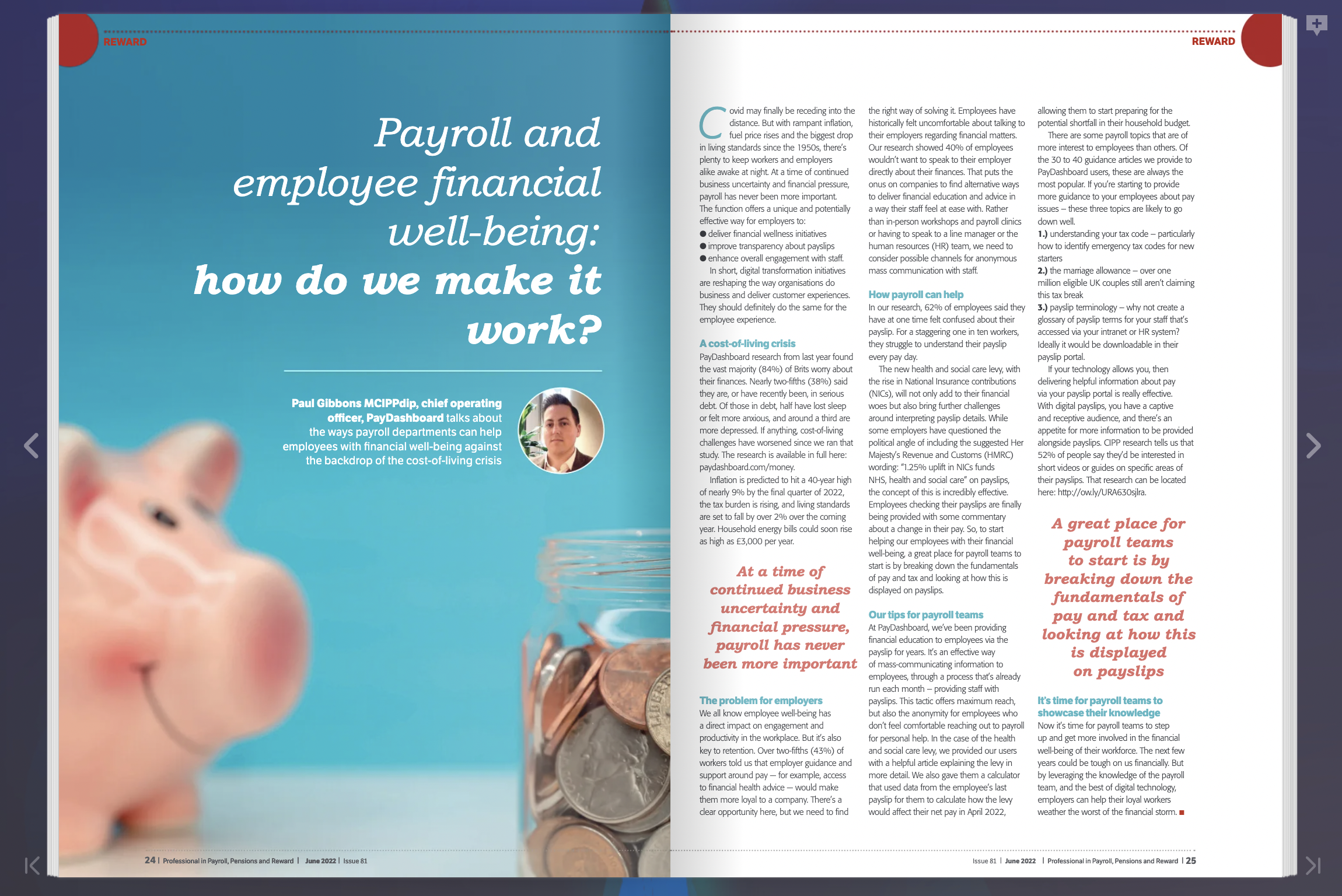Blog
Payroll & Employee Financial Wellbeing - How do we make it work?
12th July 2022
 Pay Dashboard
Pay Dashboard
By Paul Gibbons, COO - PayDashboard
COVID may finally be receding into the distance. But with rampant inflation, fuel price rises and the biggest drop in living standards since the 1950s, there’s plenty to keep workers and employers alike awake at night. At a time of continued business uncertainty and financial pressure, I believe that payroll has never been more important. Our function offers a unique and potentially effective way for employers to deliver financial wellness initiatives, improve transparency about payslips and enhance overall engagement with staff.
In short, digital transformation initiatives are reshaping the way organisations do business and deliver customer experiences. They should do the same for the employee experience.
PayDashboard research from last year found the vast majority (84%) of Brits worry about their finances. Nearly two-fifths (38%) said they are, or have recently been, in serious debt. Of those in debt, half have lost sleep or felt more anxious and around a third have become more depressed. If anything, cost-of-living challenges have worsened since we ran that study. Inflation is predicted to hit a 40-year high of nearly 9% by the final quarter of 2022, the tax burden is rising, and living standards are set to fall by over 2% over the coming year. Household energy bills could soon rise as high as £3,000 per year.
We all know that employee wellbeing has a direct impact on engagement and productivity in the workplace. But it is also key to retention. Over two-fifths (43%) of workers told us that employer guidance and support around pay—for example, access to financial health advice—would make them more loyal to the company. There is a clear opportunity here, but we need to find the right way of solving it.
Employees have historically felt uncomfortable about talking to their employer about financial matters. Our research showed that 40% of employees would not want to speak to their employer directly about their finances. That puts the onus on companies to find alternative ways to deliver financial education and advice in a way their staff feel at ease with. Rather than in-person workshops and payroll clinics or having to speak to a line manager or the HR team, we need to consider possible channels for anonymous mass communication with staff.
In our research, 62% of employees said they have at one time felt confused about their payslip. For a staggering 1 in 10 workers, they struggle to understand their payslip every pay day.
The new Health & Social Care Levy, with that rise in National Insurance contributions, will not only add to their financial woes but also challenges around interpreting payslip details. While some employers have questioned the political angle of putting the suggested HMRC wording “1.25% uplift in NICs funds NHS, health and social care” onto payslips, actually the concept of this is incredibly effective. Employees checking their payslips are finally being provided with some commentary about a change in their pay.
So, to start helping our employees with their financial wellbeing, a great place for payroll teams to start is breaking down the fundamentals of their pay and tax and how this is displayed on their payslips.
At PayDashboard, we’ve been providing financial education to employees via the payslip for years. It is a really effective way of mass-communicating information to employees, through a process that you already run each month – giving your staff a payslip. This tactic offers maximum reach, but also the anonymity for those employees who don’t feel comfortable reaching out to payroll for personal help.
In the case of the Health and Social care levy, we provided our users with a helpful article explaining the levy in more detail, and a calculator that used data from the employee’s last payslip for them to calculate how the levy would affect their take-home pay come April – allowing them to start preparing for the potential shortfall in their household budget.
There are some payroll topics that are of more interest to employees than others. Of the 30 to 40 guidance articles we provide to PayDashboard users, these are always the most popular. If you are starting out on providing more guidance to your employees about pay issues – these three topics are likely to go down well!
If your technology allows you, then delivering helpful information about pay via your payslip portal is really effective. With digital payslips you have a captive and receptive audience, and there is an appetite for more information to be provided alongside payslips. CIPP research tells us that 52% of works say they’d be interested in short videos or guides on specific areas of their payslips.
Now it’s time for payroll teams to step up and get more involved in financial wellbeing for their workforce. The next few years could be pretty tough on us money wise. But by leveraging the knowledge of the payroll team, and the best of digital technology, employers can help their loyal workers weather the worst of the financial storm.
View this article in the CIPP Professional Magazine
